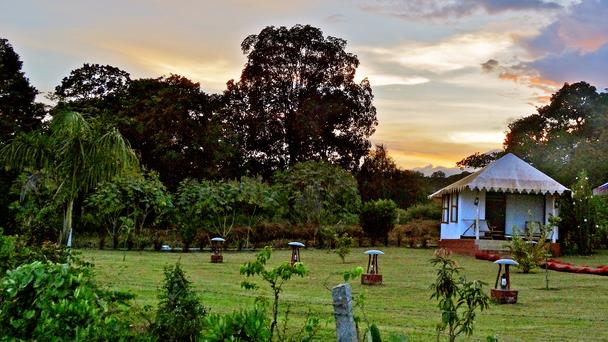From Bangalore, Karnataka’s state capital, a six-hour, 250km journey sees the landscape transform from outlandish rock formations and lush rice paddies to dense wild forests and aromatic coffee, cardamom and pepper plantations – all signs of arrival in Kodagu, Karnataka’s hill country.Better known by its anglicised name of Coorg, Kodagu, a part of the Western Ghats (a mountain range and Unesco World Heritage Site), has culture and cuisine that differs from anywhere else in India. The local Kodava people, believed to be descendants of Alexander the Great’s Indo-Greek soldiers who mingled with the natives, have a distinct warrior-like upbringing: instead of praying with the fires and chants common among Hindus, Kodava rituals have strong war-like elements, including the symbolic use of a sword to chop banana stems during weddings. Legend holds that back in the 1800s, young boys were fed tiger meat in the hope that they would grow up to be ferocious warriors – and men who were brave enough to kill a tiger were given the privilege of growing a unique curled moustache called a galle meesey. The local food is primarily meat-based, unlike in the rest of the country; signature dishes include pandi (pork curry), koli (chicken curry), and bembla (bamboo shoot). Apart from in the homes of locals, Coorg Cuisinette, located in the Stuart Hill area of Coorg’s administrative capital of Madikeri, is one of the few authentic restaurants with these delicacies. One of the most experiential ways to discover Kodagu’s culture is through home or farm stays, many of which are located on coffee plantations that were first planted by British colonials in the 18th and 19th Century. Kodagu’s Green Dreams, run by local coffee trader and connoisseur Narendra Habbar, is located on the banks of organic rice paddies and backdropped by the gentle hills of the Western Ghats. The farm stay offers accommodation in handcrafted huts built entirely with naturally and locally sourced materials such as fibreboard roofs, pumpkin lampshades and bamboo. Join Habbar for a plantation tour to track the journey of one of the finest cappuccinos you’ll ever taste, all the way from leaf to cup.Far from the traffic of many major Indian towns, Kodagu’s terrain is ideal for hiking and cycling. Fields of coffee and pepper stretch all the way to the horizon, occasionally giving way to striking scenes of lush, undulating hills and waterfalls.If the tranquillity of Kodagu’s countryside does not curb the longing for Goa’s beaches or Kerala’s backwaters, the coast of Karnataka, located 192km northwest, will; gentle backwaters serenade sleepy villages on one side, while the Arabian Sea roars fiercely on the other. Mangalore, Karnataka’s main port city, and Kaup (pronounced Kapu in the local Tulu language), one of Karnataka’s coastal towns, are unassuming gateways to the area’s virgin beaches and palm-fringed backwaters. Blue Matsya is a lone, self-catering beach house along an isolated stretch of soft golden sand – a personal beach paradise – with a fisherman’s family for hosts. Ram-anna, the caretaker, often ventures out with his fishing boat into these waters at dawn and returns home with fresh catch such as mackerel every evening, while his wife Sarsu-akka whips up gently spiced fish curries with seasonal veggies and locally grown red rice.The local communities here depend largely on fishing for their livelihood, and tourism infrastructure is still in its infancy. Even so, the villagers exude hospitality, and despite a language barrier, will walk – or row – kilometres to give you a tour of their land. Hail a tuk-tuk to drive through a utopian stretch of the coast, smelling the aromas of wood fires and homemade curries. At the north end of Kaup beach, Kaup Lighthouse – manned by generations of local guards since it was built in 1901 – offers panoramic views of the country’s west coast, giving a birds-eye view to Karnataka’s centuries-old traditions and raw natural beauty; a land that is undiscovered by the masses — for now.(BBC)ANN.Az
Southern India’s stunning secret - PHOTO
World
16:20 | 02.04.2014

Southern India’s stunning secret - PHOTO
While Goa and Kerala have the most well known beaches and backwaters in India, today these palm-fringed lagoons teem with travellers – and honeymooners. But sandwiched between them on the country’s west coast, the neighbouring state of Karnataka rewards those who dare to drift from the typical tourist trail. Pristine backwaters lie untouched, dotted with sleepy hamlets, while the seaside beaches and fertile hill country remain equally undiscovered by the masses.
Follow us !










